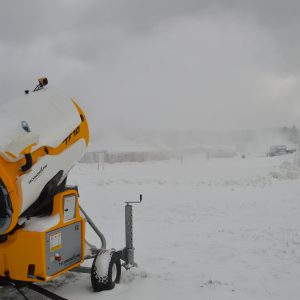ANNAPOLIS, Maryland — While many burrowed indoors the third week of November as extreme record-breaking cold impinged upon life across the Mid-Atlantic, the snow machines at Wisp Ski Resort were busy whirring and churning out a base layer of snow for the upcoming winter.
The third week of November is the earliest the ski resort has started making snow in the past five years, said Lori Zaloga, director of marketing for Wisp, in McHenry, Maryland.
Climate scientists are pretty sure of one thing: This winter, the weather could vary. A lot.

The slight snowfall that glided over most of Maryland and portions of northern Virginia late Tuesday into Wednesday morning was a prime example.
The strong cold front that enabled the changeover from rain to snow was the result of an amplified, S-shaped jet stream that dipped through the eastern U.S., said Stephen Baxter, winter weather lead at the national Climate Prediction Center.
While this swing in weather from mild to frosty was predicted by one type of model through the Christmas holiday, another model indicates milder weather from now until Santa hitches up the sleigh.
There is the chance for another wintry mix on Monday, although once again the varying temperatures make it hard to say whether the region will receive freezing rain, sleet, or snow from the holiday grab bag of precipitation.
State road crews were taking no chances this week on main arteries.
All state-numbered roads were treated Tuesday night, said Charlie Gischlar, State Highway Administration spokesman.
In the National Oceanic and Atmospheric Administration’s updated winter weather outlook, the Climate Prediction Center has forecast the likelihood of a warmer- and wetter-than-average winter for the Mid-Atlantic. However, there is also the high plausibility of frequent volatile cold snaps, similar to the one we experienced the third week of November and this second week of December, when low temperatures have dipped down into the mid-20s and low 30s across Maryland.
The Climate Prediction Center compares averages of temperature and precipitation in winters from 1981 to 2010 with those from 2004 to 2019 to see how the earlier and later trends differ.
This method gives the climate scientists an inclination as to the most recent trend in the data, and how it might project into the future.
Furthermore, in the latest outlook, researchers are forecasting that there will be a shift to a colder pattern in the Mid-Atlantic and U.S. as a whole come February into later spring, Baxter said.
One of the prominent drivers of winter weather this season will be a pattern called the Madden-Julian Oscillation, or MJO, and this phenomena can lead to colder patterns across North America, along with enhanced precipitation — or stormier weather, said Baxter.
However, a warmer and drier period normally resides over the southeast U.S. during the MJO, said Baxter, so heading south this winter to escape any cold-weather woes could be ideal.
The Northeast got a taste of winter weather extremes the first week of December with a blizzard that was ultimately caused by a low-pressure system that traveled all the way from California. This formation is “extremely rare,” according to Baxter.
Maryland escaped snow accumulation during this storm, but got some snowfall with the most recent disturbance that rolled through.
Westminster, Maryland, and Bloomfield, Maryland, were two communities that received the most of this slight glaze-over however, with about an inch accumulating, according to National Weather Service storm reports.

In cases such as these, Maryland sometimes sends emergency resources to other states, but has not done so yet, according to Gischlar.
For motorists traveling in and through the state this winter, Jorge Castillo, Maryland Emergency Management Agency spokesman, recommends drivers in Maryland keep an emergency kit in their cars equipped with extra water, snacks, a blanket and mittens.
“I think that’s the message to take home,” said Castillo. “Those extreme weather events that were once on the tail end of a bell curve … that were once outliers … are going to become more common.”
Castillo talked about the dangerous nonchalance that can result from the weather whiplashing from a high of mid-60 degrees one day, down to a high of mid-20 degrees the next.
“That kind of shift causes a false impression of what can happen,” said Castillo.
Another car maintenance plan that Jeanette Tejeda de Gomez and Ragina Ali of the American Automobile Association recommend in fluctuating winter weather is checking your tires. With sudden drops in temperature, tire pressure could suddenly drop as well.
With drops in temperature also come cold-related illnesses.
On Nov. 23-24, when the wind chill in some parts of Maryland made temperatures feel below 30 degrees Fahrenheit, there were around 10 emergency department visits related to the cold, according to the Maryland Department of Health.
Eva Coale, president of Annapolis Striders running club, experienced this extreme temperature shift during a race in the fourth weekend of November.
“Layers work best in the winter, particularly for longer distances,” said Coale, “Last weekend, I ran a race that was 23 (degrees) at start time and 51 at finish. I was peeling off layers as I went.”
Coale said there’s also an app runners can use in the variable weather, called “Dress My Run”, which can help a runner decide between adding in the extra layer or not.
Colder, drier air is what is preferred for the snow-making machines at Wisp, so that snow can consolidate into a puffier pack instead of a wet snow.
Compounding the winter weather outlook of a wetter-than-average winter, is also Wisp’s proximity to Deep Creek Lake, which can inject some moisture into the air as well.
However, Wisp is planning on opening Friday, the ski resort announced on Tuesday.
While not great for machine-produced snow, National Weather Service meteorologist Ray Martin pointed out, a wetter-than-average winter will up the chances for natural snowfall.
And with these enhanced chances, the National Weather Service relies on storm-reporters because automated sensors have not become advanced enough yet to accurately measure snowfall.
Storm reporters can be anyone who takes a two-hour long seminar on the basics of storms; sometimes these classes cover local winter storm reports.
Martin recommends that storm reporters use a “white board” as a base for a measuring stick to determine when new snow has fallen, because any surface that is not white “will be notably warmer.”
Grayline Services, based in Silver Spring, Maryland, has had requests since October for snow removal in preparation for the upcoming season, said chief financial officer of the company, Darien Gray.
Lara Ippolito, spokeswoman for The Light House, a homeless prevention support center in Annapolis, Maryland, also said there is an increased demand for their services when temperatures start to dip, as well as during snow storms.
One item they are specifically seeking this year: thermal blankets, to handle colder temperatures, said Ippolito.
Two newer ventures by the shelter have also included the offering of soup daily anytime as well as the inclusion of perishables into the food pantry offered to anyone coming in, she said.



You must be logged in to post a comment.